
The history of Qatar spans from its first duration of human occupation to its formation as a modern state. Human occupation of Qatar dates back to 50,000 years ago, and Stone Age encampments and tools have been unearthed in the Arabian Peninsula. Mesopotamia was the first civilization to have a presence in the area during the Neolithic period, evidenced by the discovery of potsherds originating from the Ubaid period near coastal encampments.

Qatar is a peninsula in the east of Arabia, bordering the Persian Gulf and Saudi Arabia, in a strategic location near major petroleum deposits. The State of Qatar occupies 11,437 km2 (4,416 sq mi) on a peninsula that extends approximately to 160 km (99 mi) north into the Persian Gulf from the Arabian Peninsula.

Ras Al Khaimah (RAK) is one of the seven emirates that make up the United Arab Emirates (UAE). The city of Ras Al Khaimah, abbreviated to RAK or RAK City, is the capital of the emirate and home to most of the emirate's residents. It is linked to the Islamic trading port of Julfar. Its name in English means "headland of the tent". The emirate borders Oman's exclave of Musandam, and occupies part of the same peninsula. It covers an area of 2,486 km2 (960 sq mi) and has 64 km (40 mi) of beach coastline. As of 2015, the emirate had a population of about 345,000.

Sonchus is a genus of flowering plants in the tribe Cichorieae within the family Asteraceae and are commonly known as sow thistles. Sowthistles are annual, biennial or perennial herbs, with or without rhizomes and a few are even woody.
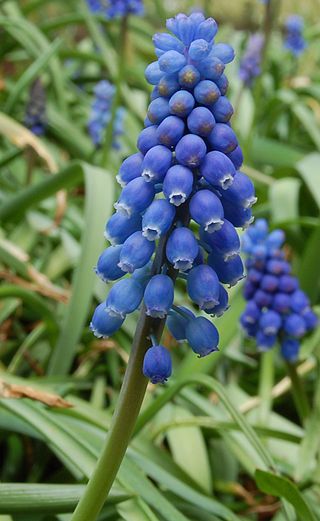
Muscari is a genus of perennial bulbous plants native to Eurasia that produce spikes of dense, most commonly blue, urn-shaped flowers resembling bunches of grapes in the spring. The common name for the genus is grape hyacinth, but they should not be confused with hyacinths. A number of species of Muscari are used as ornamental garden plants.
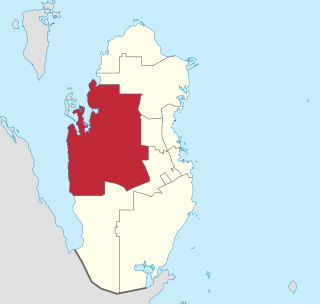
Al Shahaniya is a municipality (3299 km2) in Qatar, with its municipal seat has a city of the same name (39 km2). Formerly in the municipality of Al Rayyan, but now an independent municipality, the municipal seat was delimited in 1988 by Law No. 22. In 2014, the cabinet ratified a draft amending some provisions to the 1988 law, thereby formalizing Al Shahaniya as Qatar's eighth municipality.

Khawr al Udayd, is a settlement and inlet of the Persian Gulf located in Al Wakrah Municipality in southeast Qatar, on the border with Saudi Arabia. It is known to local English speakers as the "Inland Sea". In the past it accommodated a small town and served as the center of a long-running territorial dispute between Sheikh Jassim bin Mohammed Al Thani and Sheikh Zayed bin Khalifa Al Nahyan. At the present, it is a major tourist destination for Qatar.

Fuwayrit is a coastal village in Qatar, located in the municipality of Ash Shamal approximately 90 km north of the capital Doha. It is an important site for Qatar's oil industry. Archaeological evidence suggests that it may have been settled as early as the 16th century. Previously, it was one of the most important towns in the northern sector of Qatar, having served as the seat of power for the Al Thani who had migrated to it during the 18th century, prior to relocating to Al Bidda in 1847.

Kali tragus is a species of flowering plant in the family Amaranthaceae. It is known by various common names such as prickly Russian thistle, windwitch, or common saltwort. It is widely known simply as tumbleweed because in many regions of the United States, it is the most common and most conspicuous plant species that produces tumbleweeds. Informally, it also is known as "'salsola", which was its generic name until 2007.

Dukhan is a city in the western municipality of Al-Shahaniya in the State of Qatar. It is approximately 80 kilometres (50 mi) west of the capital, Doha. Dukhan is administrated by Qatar's state oil agency QatarEnergy and is the site of the first oil discovery in Qatar. It was previously a part of Al Rayyan municipality.
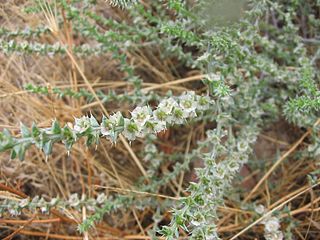
Kali is a genus of plants in the subfamily Salsoloideae in the family Amaranthaceae. Common names of various members of this genus include buckbush, rolypoly, tumbleweed for its wind-blown seed dispersal habit, and Tartar thistle and Russian thistle for its origins.

Suaeda aegyptiaca is a species of succulent plant in the family Amaranthaceae, and salt-tolerant (halophyte) plant that is distributed in eastern North Africa, the Near East and West Asia.

The flora of Lebanon includes approximately 2,600 plant species. Situated on the eastern coast of the Mediterranean Basin, Lebanon is a reservoir of plant diversity and one of the world's biodiversity hotspots for conservation priorities. Endemic species constitute 12% of the Lebanese flora; 221 plant species are broad endemics and 90 are narrow endemics. Important Plant Areas (IPAs) featuring the country exceptional botanical richness were defined in 2018.
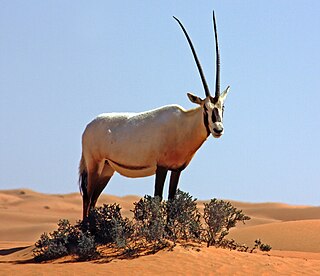
The wildlife of Qatar includes the peninsula's flora and fauna and their natural habitats. The country's terrestrial wildlife includes numerous small nocturnal mammals, a number of reptiles which mainly consist of lizard species, and arthropods. Aquatic animals primarily include fish, shrimp and pearl oysters. The desert and the shoreline form an important resting site for a number of migratory bird species during autumn and spring. Urban and agricultural developments have led to an increase in bird species.
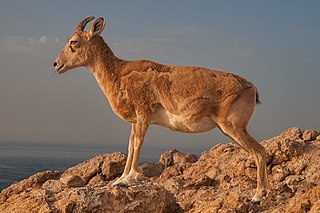
Qatar is a peninsula on the northeastern coast of the Arabian Peninsula, bordering Saudi Arabia to the south and surrounded elsewhere by the Persian Gulf. A strait separates Qatar from the island kingdom of Bahrain.

Al Wakrah Municipality is a municipality of Qatar located bordered by the municipalities of Doha and Al Rayyan. The municipal seat is Al Wakrah city.

The wildlife of the United Arab Emirates is the flora and fauna of the country on the eastern side of the Arabian Peninsula and the southern end of the Persian Gulf. The country offers a variety of habitats for wildlife including the coast, offshore islands, mangrove areas, mudflats, salt pans, sand and gravel plains, sand dunes, mountain slopes, wadis and rocky summits. Because the terrain is so varied, it supports a greater number of species of plants and animals than might have been expected in this relatively small country.

Seidlitzia rosmarinus is a perennial-green desert species of saltwort in the Amaranthaceae family. It is endemic to the lower Jordan Valley along the Dead Sea, in Israel and Jordan, and in the Syrian desert, Central Iraq and in the coastal regions of Saudi Arabia, the islands of Bahrain, Qatar, and Iran, commonly known in Arabic by the names ʾušnān and šenān and in the Neo-Aramaic languages by reflexes of ʾuḥlā. It is often used by Bedouins for cleaning as a soap substitute. In medieval Arabic literature, it is also known by the names of "green ushnan" and "launderers' potash", having been used since time immemorial to produce nabulsi soap and as an electuary in compounding theriac for use in treating scorpion stings, as well as for extracting potassium for other medicinal uses.






















